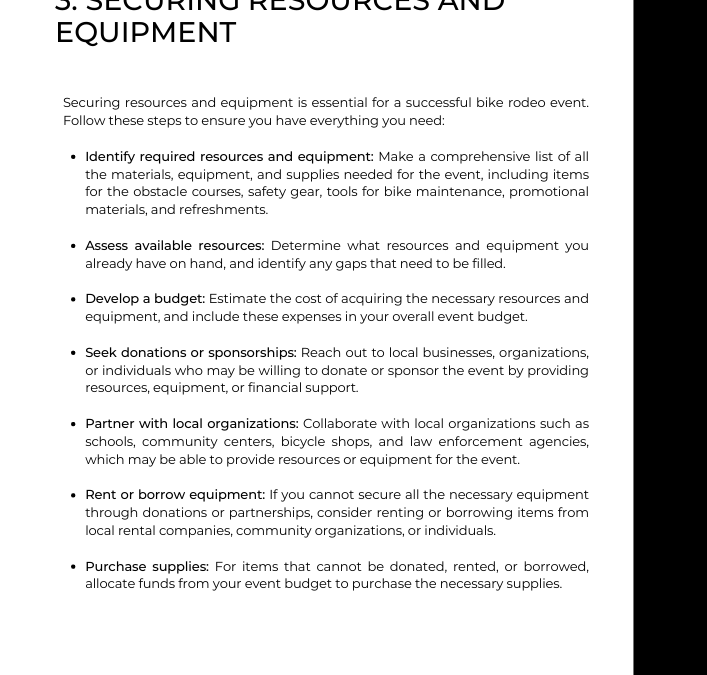Have you ever wanted a safety-oriented cycling event in your community? Have you ever wondered what it takes to organize a Bike Rodeo event? Well, we have it mapped out here for you and in even more detail in our Bike Rodeo Toolkit! Being a Bike Rodeo Coordinator is an exhilarating and rewarding role that involves bringing together individuals of all ages to promote bike safety, healthy lifestyles, and community engagement. From planning and logistics to coordinating volunteers and ensuring a seamless event execution, the Bike Rodeo Coordinator plays a pivotal role in creating a fun and educational experience for participants.
A bike rodeo coordinator is responsible for planning, organizing, and overseeing a bike rodeo event. Their main goal is to ensure that the event runs smoothly and successfully while providing a fun and educational experience for participants. Some key responsibilities of a bike rodeo coordinator may include:
Planning the event: This involves selecting a suitable date, time, and location, as well as determining the format and structure of the bike rodeo, including the number of stations and the activities that will be offered. You can create a rodeo that fits your community. Are roundabouts new in town? Set up a roundabout station. It might even be useful for some adults!
Recruiting and coordinating volunteers: A successful bike rodeo typically requires a team of volunteers to help manage various aspects of the event. The coordinator is responsible for recruiting volunteers, assigning roles, and providing them with the necessary training and information. The toolkit is full of everything you need to get your volunteers ready for the rodeo and we can help recruit more with our statewide network of members.
Securing resources and equipment: The coordinator must gather all the necessary resources for the event, such as cones, signs, and other materials for the obstacle course or mock streets. They may also need to arrange for bicycle helmets, tools for bike safety checks, and first-aid kits.
Promoting the event: The coordinator should develop a marketing plan to promote the bike rodeo, including distributing flyers, contacting local media, and utilizing social media channels to reach the target audience. We can help you reach a wider audience and help design a poster for you. The toolkit is also full of examples to help you promote your event.
Partnering with local organizations: Establishing partnerships with local organizations, such as schools, community centers, bicycle shops, and law enforcement agencies, can help provide additional resources and support for the event. Invite a local food truck, bike shop, or scout troop to your rodeo.
Ensuring safety: The coordinator should develop a safety plan for the event, which may include emergency procedures, first-aid provisions, sunscreen, and coordinating with local law enforcement for traffic control or security, if necessary.
Managing the event on the day: On the day of the bike rodeo, the coordinator must oversee all aspects of the event, from setup and registration to managing volunteers and handling any issues that may arise.
Evaluating the event: After the bike rodeo, the coordinator should gather feedback from participants, volunteers, and partners to evaluate the event’s success and identify areas for improvement in future bike rodeos. The coordinator should report event metrics and feedback to the Iowa Bicycle Coalition to help build better events all around Iowa.
All this can seem overwhelming at once but even if this is your first rodeo, our Bike Rodeo Toolkit will supply you with the information and tools you need to host a memorable day for your community. We are of course always happy to help provide guidance, promote, and wrangle up volunteers. Feel free to contact us at matt@iowabike.org
And you can check out our other guides right here.
Big Bike Give is Tuesday, but early giving is open! You can support Safe Routes by helping us reach our matching grant goal.

